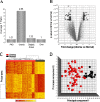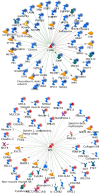Alteration of human blood cell transcriptome in uremia
- PMID: 23809614
- PMCID: PMC3706221
- DOI: 10.1186/1755-8794-6-23
Alteration of human blood cell transcriptome in uremia
Abstract
Background: End-stage renal failure is associated with profound changes in physiology and health, but the molecular causation of these pleomorphic effects termed "uremia" is poorly understood. The genomic changes of uremia were explored in a whole genome microarray case-control comparison of 95 subjects with end-stage renal failure (n = 75) or healthy controls (n = 20).
Methods: RNA was separated from blood drawn in PAXgene tubes and gene expression analyzed using Affymetrix Human Genome U133 Plus 2.0 arrays. Quality control and normalization was performed, and statistical significance determined with multiple test corrections (qFDR). Biological interpretation was aided by knowledge mining using NIH DAVID, MetaCore and PubGene
Results: Over 9,000 genes were differentially expressed in uremic subjects compared to normal controls (fold change: -5.3 to +6.8), and more than 65% were lower in uremia. Changes appeared to be regulated through key gene networks involving cMYC, SP1, P53, AP1, NFkB, HNF4 alpha, HIF1A, c-Jun, STAT1, STAT3 and CREB1. Gene set enrichment analysis showed that mRNA processing and transport, protein transport, chaperone functions, the unfolded protein response and genes involved in tumor genesis were prominently lower in uremia, while insulin-like growth factor activity, neuroactive receptor interaction, the complement system, lipoprotein metabolism and lipid transport were higher in uremia. Pathways involving cytoskeletal remodeling, the clathrin-coated endosomal pathway, T-cell receptor signaling and CD28 pathways, and many immune and biological mechanisms were significantly down-regulated, while the ubiquitin pathway and certain others were up-regulated.
Conclusions: End-stage renal failure is associated with profound changes in human gene expression which appears to be mediated through key transcription factors. Dialysis and primary kidney disease had minor effects on gene regulation, but uremia was the dominant influence in the changes observed. This data provides important insight into the changes in cellular biology and function, opportunities for biomarkers of disease progression and therapy, and potential targets for intervention in uremia.
Figures




References
-
- Meyer TW, Hostetter TH. Uremia. N Engl J Med. 2007;357(13):1316–1325. - PubMed
-
- Almeras C, Argilés A. The general picture of uremia. Semin Dial. 2009;22(4):329–333. - PubMed
-
- Vanholder R, Baurmeister U, Brunet P, Cohen G, Glorieux G, Jankowski J. A bench to bedside view of uremic toxins. J Am Soc Nephrol. 2008;19(5):863–870. - PubMed
Publication types
MeSH terms
Substances
Associated data
- Actions
LinkOut - more resources
Full Text Sources
Other Literature Sources
Medical
Molecular Biology Databases
Research Materials
Miscellaneous

